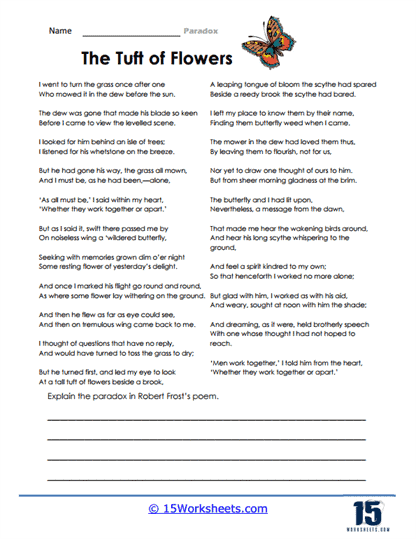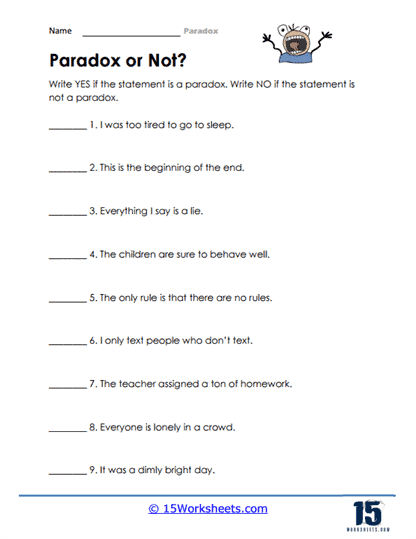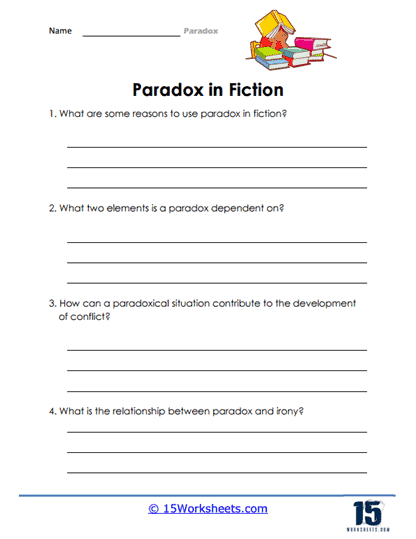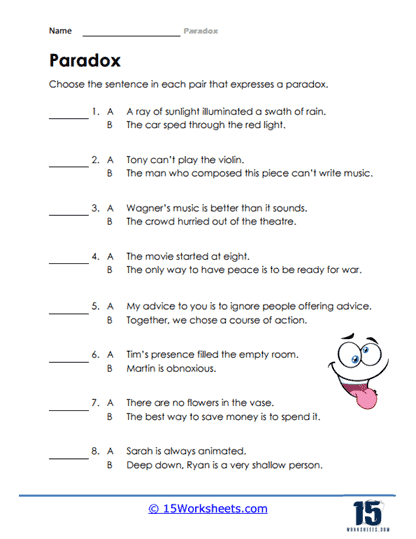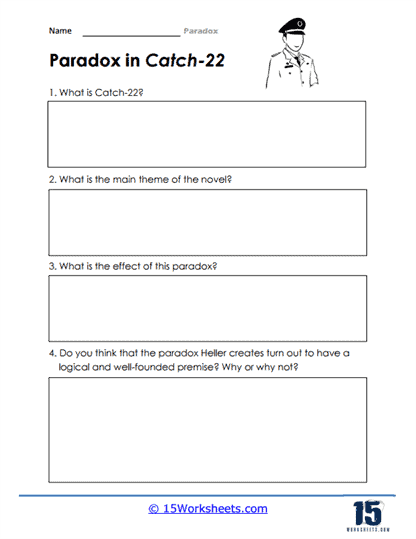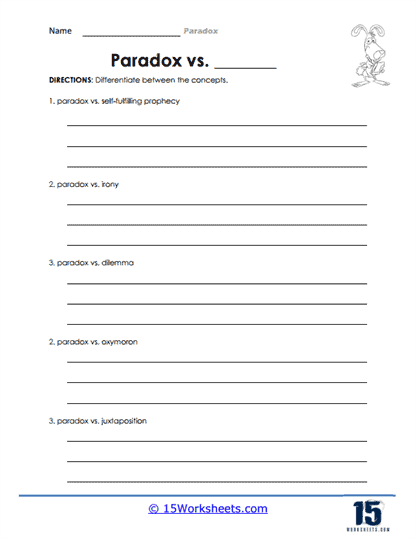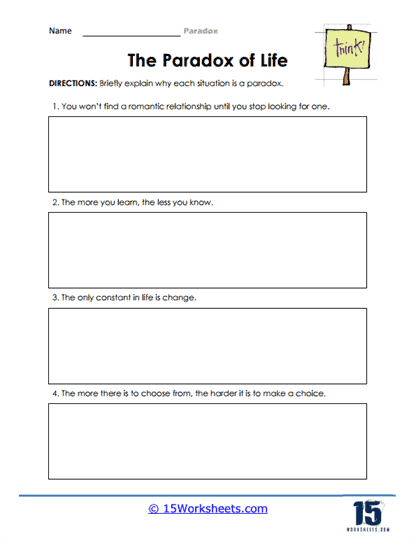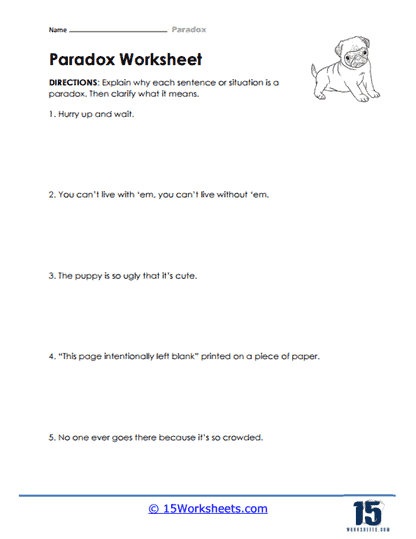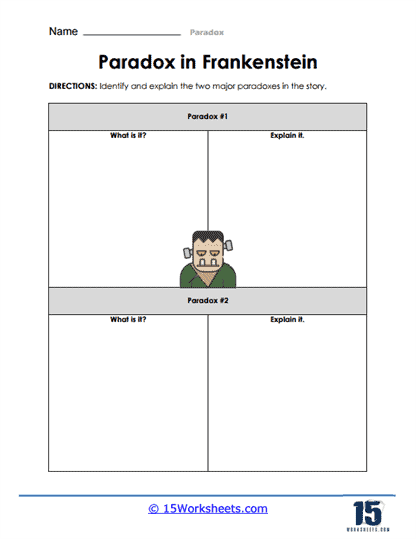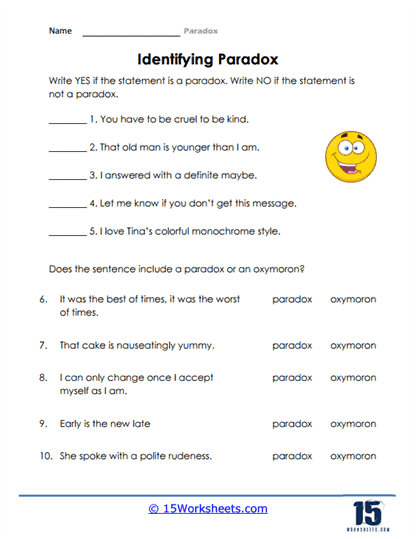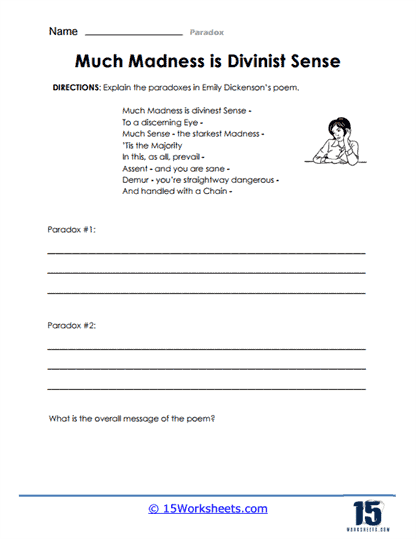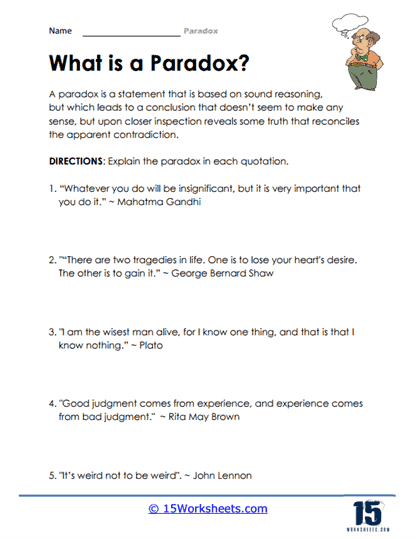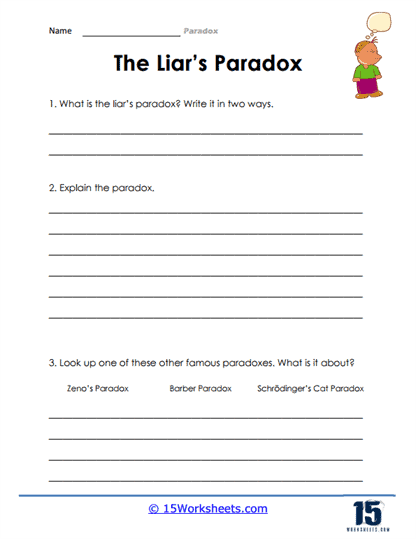Paradox Worksheets
All About These 15 Worksheets
Paradoxes, statements or situations that appear self-contradictory or illogical but, upon closer examination, reveal deeper truths, are fascinating intellectual puzzles that have intrigued thinkers for centuries. Understanding paradoxes is not only important for cultivating critical thinking but also for encouraging curiosity, challenging assumptions, and expanding intellectual horizons. This collection of 15 worksheets is designed to introduce students to the world of paradoxes, helping them grasp the importance of this intellectual concept, recognize its prevalence in various fields, and develop their own problem-solving and analytical skills.
What Are Paradox Worksheets?
Paradox worksheets are helpful to teach and practice the concept of use of paradoxes as literary devices. A paradox is a seemingly self-contradictory statement or proposition that, when investigated or explained, may prove to be well-founded or true. In literature, paradoxes are used to induce thought, add intrigue, or lead readers to fresh insights and perspectives.
These worksheets contain a variety of exercises aimed at helping students understand and work with paradoxes. These activities may range from identifying and analyzing paradoxes in literary excerpts to creating their own paradoxical statements. These worksheets can be adapted to various grade levels, based on the complexity of the exercises and the depth of understanding required. You will find the following types of activities on these worksheets:
Identification – These exercises usually provide students with sentences or passages, asking them to identify which ones contain a paradox. This practice helps students become familiar with the concept of a paradox and how it’s used in writing.
Analyzing – Students may be given specific examples of paradoxes and asked to explain why they are paradoxes and what they mean. This type of exercise helps students learn to think critically about paradoxes, going beyond the surface-level contradiction to uncover the deeper truth or insight the paradox offers.
Creating Your Own – These exercises often involve creative writing prompts where students are asked to write their own paradoxical statements or a short paragraph containing a paradox. This not only encourages creativity but also allows students to apply their understanding of the concept in a practical way.
Comparing and Contrasting – In these exercises, students might compare different paradoxes to understand their meanings or effects better. They might discuss the emotions evoked, the questions raised, and how paradoxes challenge conventional thinking.
Examples in Literature – Students might be asked to identify and interpret the paradoxes in given excerpts from famous literary works. They could also be tasked with explaining how the paradox enhances the text – whether by adding depth to a character, underscoring a theme, or enriching the plot.
Discussion and Essay Prompts – Paradox worksheets might also feature prompts for discussion or essays. For instance, students could be asked to discuss the purpose and effect of using paradoxes in literature, or how paradoxes can alter a reader’s perspective or understanding.
These worksheets provide a structured way for students to understand the concept of paradoxes and their use in literature. They encourage critical thinking, as students must look beyond the apparent contradiction in a paradox to find the underlying truth. By identifying, analyzing, and creating paradoxes, students can gain a more profound understanding of this literary device and how it contributes to the richness and complexity of literary texts.
What is the Literary Device of Paradox?
A paradox is a rhetorical device or a concept that can be both strange and insightful. A paradoxical statement can be seemingly contradictory or opposed to common sense, yet upon closer inspection, it might contain an underlying truth. The primary purpose of using a paradox is to provoke readers’ thought and focus their attention on the theme or the character.
In literature, paradoxes give more profound meaning to words and expressions. They make the readers think over the ideas presented by the author more intensively and inspire them to look at things from a new perspective. Paradoxes are especially powerful because they encourage readers to transcend the surface meaning of the text and grapple with the deeper, more nuanced implications.
The main defining feature of a paradox is that it seems self-contradictory or absurd, but in reality, it might contain a plausible or rational truth. Paradoxes are often used to illustrate an opinion or statement contrary to accepted traditional ideas. They are effective for engaging a reader or listener and encouraging cognitive exploration and critical thinking.
Examples In Well Known Literature
“It was the best of times, it was the worst of times” from “A Tale of Two Cities” by Charles Dickens
This opening line of the novel presents a classic example of a paradox. At first glance, it seems impossible for it to be both the best and the worst of times. However, Dickens uses this paradox to highlight the dualities of the French Revolution, which brought about hope of equality and fraternity (‘the best of times’) but also widespread violence and suffering (‘the worst of times’). This paradox serves to capture the complexity and contradictions inherent in this historical period.
“I must be cruel to be kind” from “Hamlet” by William Shakespeare
This statement made by Hamlet is a paradox. How can one be cruel and kind simultaneously? However, in the context of the play, Hamlet needs to hurt his mother with harsh truth to ultimately help her understand the villainy of his uncle, Claudius. This paradox underlines Hamlet’s internal struggle and the complex moral dynamics at play in the narrative.
“Men work together… Whether they work together or apart” from “The Rock” by T.S. Eliot
This paradoxical statement suggests that men are working together, even when they’re working separately, an assertion that initially seems contradictory. However, Eliot is expressing a deeper truth about the interconnectedness of human efforts and experiences. Even when we work separately, our individual efforts contribute to the collective progress of humanity. This paradox provokes thought about the nature of individual and collective human endeavor.
Paradoxes are a powerful literary device that can make readers question their preconceived notions and encourage them to engage more deeply with a text. A paradox starts as a statement that appears self-contradictory but reveals a surprising, often profound, truth upon closer examination.
By challenging traditional logic and encouraging us to see things from a different perspective, paradoxes can deepen our understanding of the characters, themes, and contexts of a literary work. They remind us that reality is often more complex and nuanced than it first appears, and that truth can sometimes be found in seemingly contradictory ideas.
Benefits Of These Paradox Worksheets To Students
Exploring the world of paradoxes through this collection of 15 mind-bending worksheets offers students an opportunity to develop essential skills in critical thinking, intellectual curiosity, philosophical exploration, problem solving, and cognitive flexibility. Paradoxes are intellectual puzzles that challenge our assumptions and provoke deeper understanding, making them valuable tools for expanding students’ intellectual horizons.
By engaging with these exercises and activities, students not only enhance their academic abilities but also gain valuable tools for navigating the complexities of logic, language, and perception. The benefits of studying paradoxes extend far beyond the classroom, empowering students to be more curious, analytical, and adaptable thinkers in an ever-evolving world of ideas and knowledge.


